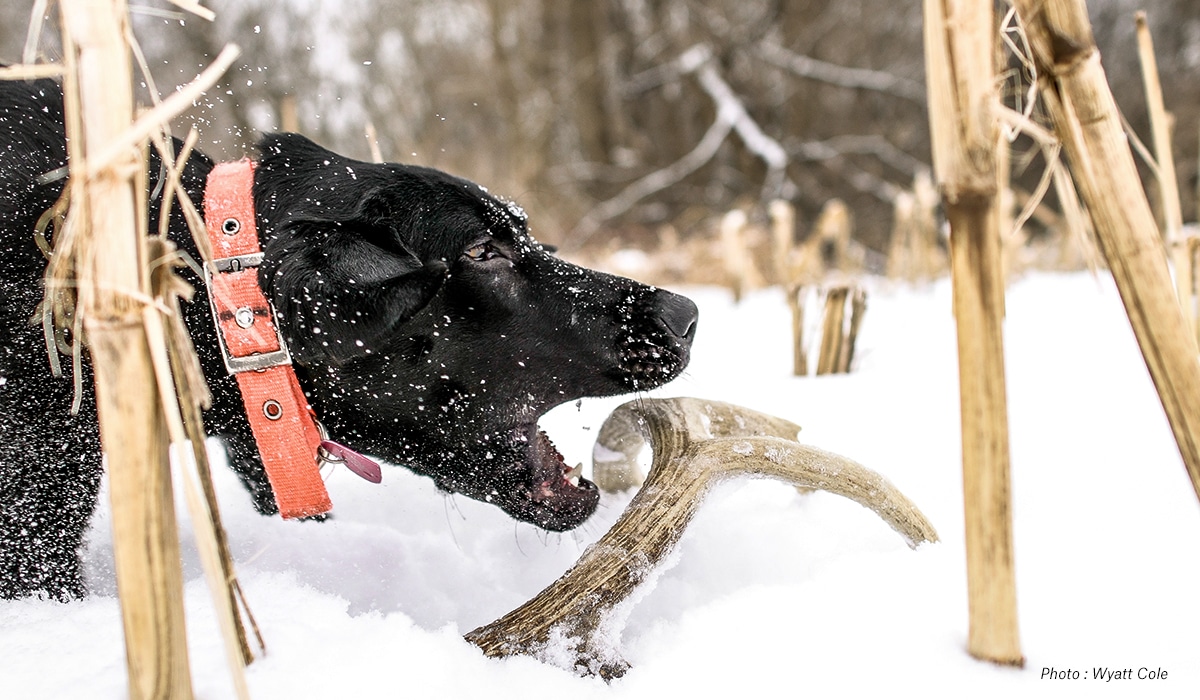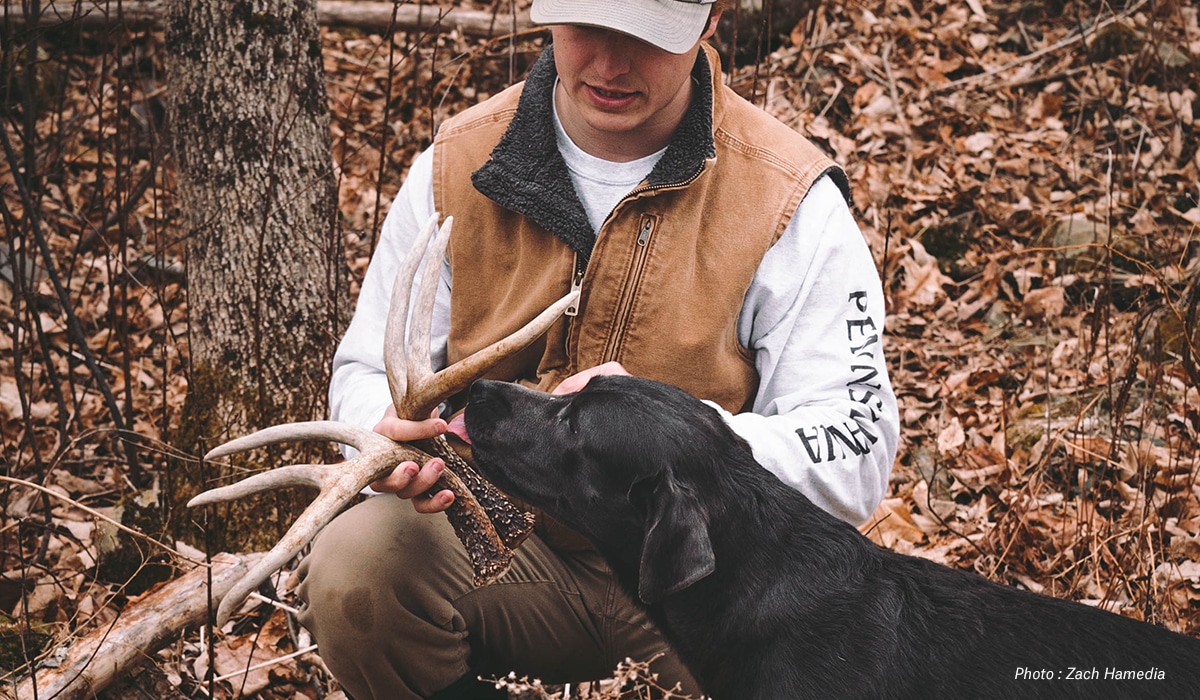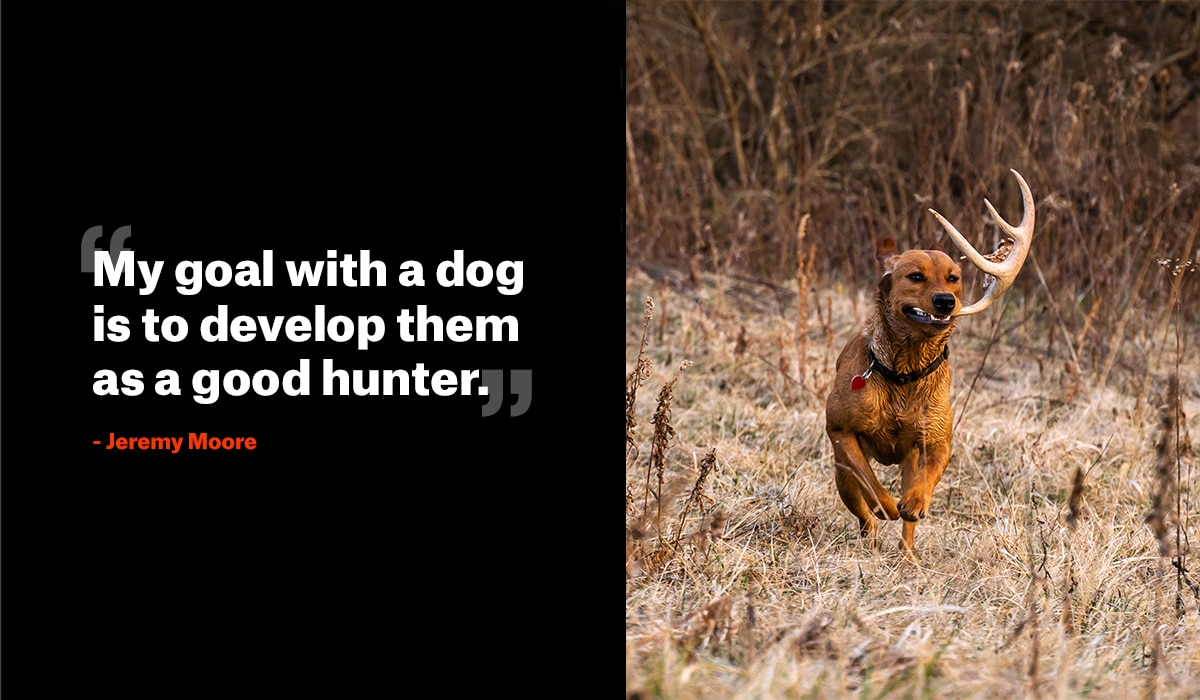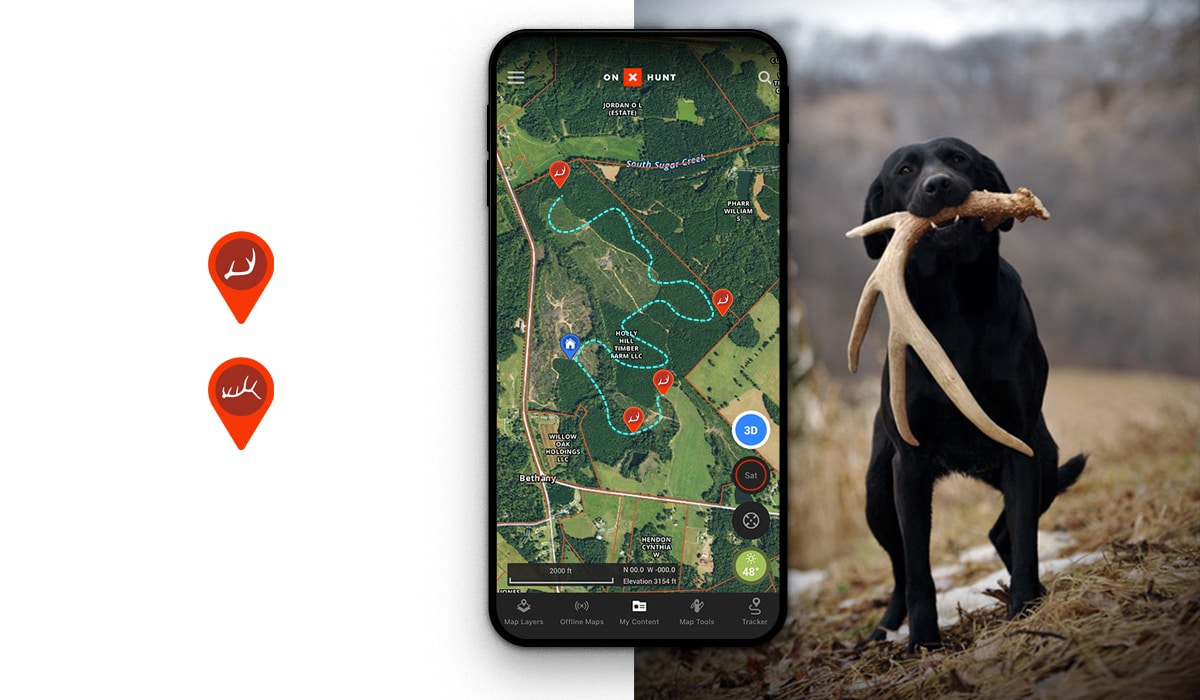Shed hunting dogs have dramatically gained in popularity over the last decade. The appeal is certainly noteworthy—you and your four-legged hunting companion roam the woods together in the off-season to find freshly shorn relics of bucks and bulls that survived another year. Relying on scent and sight, your shed hunting dog finds half-hidden treasures and retrieves them for you. The activity strengthens the bond between owner and canine during the months you probably both wish you were hunting real game.
Shed hunting, whether for fun or profit (sheds can fetch between $7-14 per pound), can serve as its own end-goal or as part of the overall training regimen for virtually any hunting dog. Some breeds may have better instincts for shed hunting than others, but most gun dog breeds are more than capable of the task. It’s all in how you train them.
Training shed hunting dogs is what Jeremy Moore is renowned for in the U.S. As the owner of DogBone, Moore has helped owners train virtually every kind of dog imaginable to be a shed hunting dog. He helped us sift through the evolving strategies, myths, and opinions when it comes to finding sheds with dogs.
“We’re really big on the idea that people can do this themselves,” Moore says. “I don’t think you need to send your dog off to a trainer. I just think that there’s a lack of understanding how to get there.”
Moore has been training shed hunting dogs for over 15 years after stumbling into it as a hobby, just something fun for him to do with his retriever. Not fully understanding the risk of training a young dog with a soft mouth with a real antler, Moore’s puppy poked itself on the first antler it encountered and then wanted nothing more to do with them. This inspired him to create a soft training shed and specialized antler scent. He followed up by creating training materials and clinics for those who want their own dogs to hunt sheds.
His training style emphasizes a low-pressure, positive approach that maximizes a dog’s potential in a very natural way. Moore doesn’t believe in the use of force, fear tactics, avoidance training, or electronic collars.
When considering training a dog to shed hunt, a lot of people are focused on three main topics: picking the best dogs for shed hunting, knowing how to train a dog to hunt sheds, and understanding how dogs find sheds. With Moore’s insight, we’ll cover all these.

Best Shed Hunting Dogs
“I’ve seen just about every type of dog you can imagine come to our workshops,” Moore says. “Some of them are pointing dogs. Some are herding dogs. A lot of them are retrievers. Different types of dogs are capable of hunting sheds. It’s just a matter of modifying the training to get them there.”
Depending on who you ask, the breed that makes the best shed hunting dog will vary. Combing through most of the articles, blogs, forums, and books on the matter you’ll see several of the same breeds pop up as the “Best Shed Hunting Dogs.” That list would look something like this:
- Retrievers (Golden, Labrador, British, Chesapeake Bay)
- Pointers (German Shorthaired, Pudelpointer)
- English Setter
- English Springer Spaniel
- American Foxhound
- Beagle
- Weimaraner
- Bloodhound
Sage advice that persists about shed hunting dogs, however, is that you don’t need to acquire a new dog to train for finding antler sheds. As long as a dog has the ability to retrieve and be trained, it can be successful at finding sheds.
“I like a dog that’s going to search for me,” Moore says. “I like a dog that searches within reasonable distance, partly because I also use these dogs for upland bird hunting. The crossover to shed hunting is very similar to upland hunting.”
Moore’s personal choice for a shed hunting dog is a British labrador. “But it’s my favorite because it fits me,” he says. “It fits the right training style, the right lifestyle, and the right hunt style for me. I think the key is matching up. When you properly pair up the dog owner to the dog, that’s when it works. That’s when you find success, and that fit is different for different people.
“When it comes to what’s the best dog to shed hunt with, I think the answer is dependent on matching those three things (training style, lifestyle, hunting style) and the individual that’s doing the training and living with that dog,” Moore says.

How Dogs Hunt Sheds
Shed hunting is about knowing when and where to look for sheds. Knowing those things will help you find the right time and places to take your dog out to find antlers. But also understanding how your dog will work to find sheds can help you score your best sheds yet.
“The dog should understand there’s certain smells and there’s certain shapes that equal retrieve,” Moore says. “But you have to tap into something that they do naturally. If you have a pointing dog, you want to bring out their natural point. If you have a retriever, it’s real simple, certain smells and certain shapes equal retrieve. That’s what drives the retriever. The retrievers don’t retrieve birds because they like birds. They retrieve birds because they like to retrieve, and we teach them that certain things are worth retrieving. So the antler is just another thing worth retrieving.”
Great shed hunting dogs are trained, at least according to Moore’s methods, to rely almost equally on sight and smell.
“I like to make it easy at first,” he says, “so I have them understand that certain shapes are things to pick up and bring back. And then certain smells are worth going to look at and to find out if that shape is there. You smell something, you should go look at it, and if it’s there, pick it up. If it’s not there, keep moving, keep looking.”
“It’s natural for a dog to search first by eyesight,” Moore says. “I think they are always scanning. Their noses are always running too, but if you’re a dog you’re always looking to be efficient. For a dog, they’re wondering, ‘How can I get this thing in my mouth and get a retrieve in the least amount of steps.’ If they’re scanning and they see it and get it, that’s it—one step. If they have to smell it first, then go see it, then get the retrieve, you’ve added a step.”
With Moore’s training, he’s wanting to get the dogs working at a 50:50 ratio between sight and smell. Being big on balance, Moore believes a dog that hunts with dominant preference for sight over scent, or vice versa, will have a harder time adjusting when the other sense is needed.

How To Train a Dog To Shed Hunt
There is an important distinction between training a dog to shed hunt and most other hunting dog training, and that is the frequency of actual retrieves. Moore puts it this way: “We could go to a game farm and we could put dogs on 100 pheasants in a day if we wanted to, because all you can do is pay for it and they put them out and you can go hunt them. I don’t know very many people today that are going to find 100 sheds this year, but at best that would be 100 opportunities for the light bulb to turn on for the dog.
“The average person may find one or two a year in a good year,” he says, “and so you go look at the lack of opportunity that you’re giving your dog to really make it happen. Then you get into the issue where the first or second time you find an antler, your dog doesn’t pick it up and so you get frustrated. You get down on the dog and you’re disappointed and get to the point you say, ‘Oh hell with it, I’ll just go pick it up myself.’”
Moore’s solution to this is for the owners to set the expectation for their dogs and themselves that it will take multiple seasons of success for the dog to be a fully trained shed hunting dog. “I think each season has to be looked at as its own individual opportunity to start and get them to understand,” he says.
After setting that expectation, training is about repetition and experience in order to get what you want from it. “My goal with a dog is to develop them as a good hunter,” Moore says.
“I like a dog that works relatively close,” he says. “I like a dog that covers ground, quarters, and casts. I like dogs that when they find sheds they pick them up and bring them back to me, just like if they find a crippled bird, they pick it up and bring it back to me. That’s my preferred style of hunt.
“But some people don’t want the dogs touching the antlers because they want to see where the antler was. They want to take pictures of it as it lays, and so you can teach a dog to find something and sit down. You can teach the dog to find something and bark if you want.”
Training a dog to shed hunt happens incrementally. If you’re training a puppy, start with a balled-up sock and get the puppy in a hallway where all the doors are closed. Given that many dogs like to fetch something and run away, giving the puppy only one option to retrieve and return to you will instill this concept.
Sooner than later, you’ll want to introduce the antler. Moore sells a soft antler and scent so others won’t have to go through what he did with his puppy poking itself. With that introduction, it’s important to make the discovery and retrieval of antlers exciting for the dog, giving them lots of praise upon finding a shed. Then it’s about challenging the dog in a controlled manner.
“I think it’s logical to take away the unknowns,” says Moore. “Take away the uncontrollable and develop an understanding of the game in a real, controlled environment. Then slowly add distractions to it, or temptations, or outside influences that the dog has got to sift through, both mentally and physically. That’s the way we do it.
“If you do a good job, you stay patient and work through whatever the reason why it’s not making sense to the dog,” Moore says, “and you assess that and make appropriate changes, then all of a sudden dog will get it. Then it becomes a habit, and then once it’s a habit, it’s there.”

Does a Dog Mean More Sheds?
Some hunters might be interested in training their dogs to hunt sheds because they believe that it will bring them greater spoils in the woods. While it’s true that a well-trained shed hunting dog can cover about five times more ground than a human shed hunter, having one dog help you hunt for antlers will only average about a 25 to 50 percent boost, according to Moore. But for plenty of us, that’s more than enough.
Shed hunting with a dog is (or at least should be) about spending time outdoors in the off-season giving our pups a well-rounded hunting experience. It’s something to do in-between hard waterfowl or upland hunting seasons. It’s time to bond.
But maybe you do want more. Maybe you want your dog to be an antler-seeking machine. If so, check out and consider joining a group like the North American Shed Hunting Dog Association (NASHDA), which hosts field trials, events, and shed hunt tests.
Any way you pursue shed hunting with your dog, be sure to drop the “Shed Antler” icon as a Waypoint in your onX Hunt App, or better yet snap a picture of your find and create a Photo Waypoint.